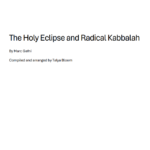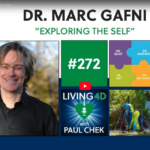L’Shanah Tovah U-Metukah: Re-Reading Rosh Hashanah
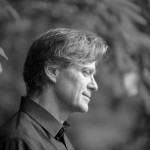 Enjoy this excerpt from the new book Tears: Reclaiming Ritual, Integral Religion, and Rosh Hashana by Dr. Marc Gafni that will be published with Integral Publishers. An earlier version of this article was published in 2008 as part of a longer article. Tears is available on Amazon here.
Enjoy this excerpt from the new book Tears: Reclaiming Ritual, Integral Religion, and Rosh Hashana by Dr. Marc Gafni that will be published with Integral Publishers. An earlier version of this article was published in 2008 as part of a longer article. Tears is available on Amazon here.
Re-Reading Rosh Hashanah
In our readings of Rosh Hashanah over the years, it has seemed to us that the classical understanding of Rosh Hashanah as a day of judgment, true and important as it may be, misses something central about the holiday. It is worth recalling the observation of the thirteenth-century scholar and mystic Rabbi Moshe ben Nachman (Nachmanides), that nowhere in the biblical text is Rosh Hashanah identified as a day of judgment. In the meditation of this Neo- Hassidic tract we would like to suggest a fundamental paradigm in our understanding of Rosh Hashanah. This shift will be rooted not in fanciful conjecture but in a close reading of the Rosh Hashanah texts themselves. This is the evolutionary mystical process which evolves the consciousness of the manifest god.
However, all of this in no way implies that we hold the notion of Rosh Hashanah being a day of judgment as in some sense wrong. Of course Rosh Hashanah is a day of judgment. This expresses our relationship to God as a Divine other, God as second person — as we have seen; a critical face of the Divine. This is the core of the Hebrew belief in ethical monotheism. Ethical monotheism is the direct knowledge, through intense spiritual practice and the gifts of translucent illumination, that there is one God; one God who includes all of reality, who is all of reality. This God, who is ultimately empty of all that is not real, is the ultimate fullness and reality of all. This God is not at all impersonal. This God is personal, though not in the primitive Santa Claus sense where God is a cosmic vending machine for our every desire. Rather, this God is personal Plus, not personal Minus. God is far more than Personal but in no sense less than personal. God is Ayin and Sunyatta and God knows your name. The primary demand of this face of God is ethical behavior for which we are held accountable and judged in love. The time-honored virtues of compassion, charity, loyalty, honesty, discipline, joy, self-sacrifice and ethical action are the code of allegiance to this God. This is the face of the Divine that we glimpse in Biblical and Prophetic consciousness. This is the Rosh Hashanah of Judgment. However, this is not the end of the story. The Rosh Hashanah of judgment over actions deepens into a Rosh Hashanah of growth and transformation where we are called to reveal and evolve our highest spiritual and emotional selves. This is the realization of our very divinity
The Path of Tears
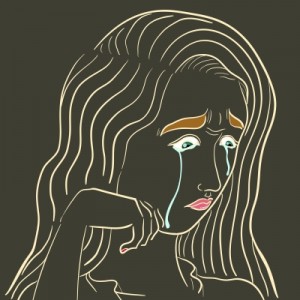 In the vision of Rosh Hashanah that we will unpack from hidden strains of texts in the classical sources themselves, God is as concerned with the evolution of our tears as with the rightness of our actions. Indeed, the former shapes the latter. At this level of Rosh Hashanah consciousness, we seek to learn the language of our tears. Tears emerge as the major currency of evolution in the deepening and transformation sought on Rosh Hashanah. At this level of consciousness, the human being is called not only to right action derived from obedience to the Divine will but to right action that emerges from the depth of one’s newly realized Divine center. And this Divine center is realized when one becomes a Master of Tears. These two levels of understanding Rosh Hashanah are not in discord. Rather they dance and deepen into each other in an ascending melody of realization.
In the vision of Rosh Hashanah that we will unpack from hidden strains of texts in the classical sources themselves, God is as concerned with the evolution of our tears as with the rightness of our actions. Indeed, the former shapes the latter. At this level of Rosh Hashanah consciousness, we seek to learn the language of our tears. Tears emerge as the major currency of evolution in the deepening and transformation sought on Rosh Hashanah. At this level of consciousness, the human being is called not only to right action derived from obedience to the Divine will but to right action that emerges from the depth of one’s newly realized Divine center. And this Divine center is realized when one becomes a Master of Tears. These two levels of understanding Rosh Hashanah are not in discord. Rather they dance and deepen into each other in an ascending melody of realization.
Levels of Consciousness
The Third Sacred Methodology
What we are teaching here is that Rosh Hashanah can and needs to be understood differently on different levels of consciousness. We approach every text, holy day and ritual on three distinct levels of consciousness, levels that we have unpacked from the teaching of the Baal Shem Tov, the 18th-century Rabbi Israel “Master of the Good Name.” Although the Baal Shem does not use terminology like “levels of consciousness,” my reading of this construct into his thought is correct, reflecting the deeper intention of his teaching. Each level, to borrow an idea from Hegel, and precise nomenclature from Ken Wilber, transcends and includes the previous level. That is to say, each level takes the core truth of the previous level, internalizes it, and then moves beyond it to a deeper level of consciousness.
One can easily map out these levels of consciousness by tracing the key liturgical mantra as well as the key ritual of Rosh Hashanah. The mantra is one word: HaMelech, literally translated as the King but more accurately implying “Master of Counsel.” At each one of these levels of consciousness, the term HaMelech, which is the central mantra of the Rosh Hashanah liturgy, assumes a different meaning. Similarly, the core ritual of shofar blowing means something very different at every level of consciousness. Usually, different interpretations of a ritual or liturgical phrase are understood to be in conflict with each other. They are described in classic study as being in Machloket, the oft-used word in Talmudic lingo for conflicting opinions that seem to be mutually exclusive. Integral Judaism, however, does not read these opinion as being either mutually exclusive or in an essential conflict. Instead, integral understanding views them as reflecting different levels of consciousness. These levels of consciousness apply to all areas of human endeavor and consciousness. Therefore, to get a general sense of how these levels work we will first apply them to stages in loving and only then to Rosh Hashanah.
The first of the Baal Shem’s levels of consciousness is termed in Hebrew Hachna’ah, generally translated as “submission.” This is the level of falling in love. At this level, each side is in complete submission to the other. “Honey, what movie would you like to see?” one asks the other. The response: “Honey, whatever movie you want is great with me; as long as we are together.” This level of consciousness, which paradoxically appears to be highly personal and relational, is actually highly impersonal. It is about this level of consciousness that poet William Blake wrote, “Love is blind.” One falls in love not so much with the other as with the experience of love itself, or with the sweet seduction of breaking out of one’s own loneliness. However, this level does not offer genuine union with other; rather it offers fusion in which both parties are not in relationship with each other but have both given themselves up on the paradoxically impersonal altar of their love. When this level of Hachna’ah is applied to Rosh Hashanah, it is similarly impersonal. At this level, one comes before God the king and creator as a subject and submits in total surrender to the will of the King who seeks nothing but the enlightenment and good of his subjects. At this level, the subject does not dare to speak to the king in second person, but rather relates to the King in third person as the great inaccessible but all knowing cosmic force of law, Dharma, healing and transformation before whom we are called to surrender. This is the King, the far away and inaccessible great emperor before whom we submit. One did not have a second person relationship with the Holy Roman Emperor. The king in this image incarnates all of reality before whom one bows and pays homage. At this level, the shofar trumpets call us to loyalty and alignment to the Cosmic King before whom all of creation bows.
This is an essential note in the Rosh Hashanah symphony without which the entire composition would lose its transformative texture and sound. And yet one note does not a compelling symphony make. God in the third person. Hachna’ah — submission — the first level of Rosh Hashanah consciousness, is essential but insufficient. One of the great weaknesses of third person fealty is that, in the end, genuine surrender without second person relationship does not hold.
Homo Yearnius
The human being is a being of yearning. Homo Yearnius. The three primary longings of the human being are for Good, for Liberation, and for Relationship. While this holy trinity was often given different names, some version of these fundamental three longings shows up all over what philosopher Leibniz called “the perennial philosophy,” the great truths about reality shared by all the great wisdom transitions over the ages. Indeed, the perennial philosophy is the history of human yearning that is the history of humanity itself. The Third person encounter with God gives context and guidance for all of these. Understandings of reality derived from many fields of knowledge which inform the great quests for freedom, relationship and goodness, are the stuff of God in the third person. The third person relationship naturally unfolds in the fullness of time to the theologies, the sciences and the various moral and social philosophies and psychologies. All of these are holy. All have a place. All are gazes and glances from the face of God. And yet, third person God by itself is ultimately unable to significantly sate any of these three great longings. The third person God, who is inaccessible to personal embrace or dialogue, ultimately devolves, becoming de-personalized, distant and alienating. The commanding other in the third person cannot hold the attention, let alone the personal loyalty, of his subjects. Third person glimpses of the Divine face are insufficient to redeem the human being from his loneliness, to liberate him, or to foster ethos and compassion as the guiding principles of a life. So man’s consciousness, driven by his yearning for the good, for freedom and for relationship, is moved to ascend and deepen to second person God talk.
 The second level of consciousness, termed by the Baal Shem as Havdalah, is about separation or distinction. This level is partially captured by the sense of the relatively modern psycho-spiritual term, “individuation.” Continuing our application of these levels of consciousness to loving, havdalah is the stage when the two individuals fall out of love. If initially the response to “Honey, what movie do you want to see” was, “Anything you want as long as I am with you” — now the response is: “See the movie by yourself” — “I am going somewhere else,” or “I have work to do at home,” etc. In the second stage, the individual breaks the spell of fusion and stands once again as a separate and individuated being. This is often a painful shock that creates great stress and trauma for the relationship, often actually causing its dissolution. However, once this is recognized as a natural and healthy evolution of the consciousness of loving, it can be engaged in an entirely different way. It is at level two where the individuals are invited to do the work and earn the free grace they received from level one, falling in love. Applied to Rosh Hashanah, this second level of consciousness, havdalah, means that the individual moves from object to subject and stands before God as a significant other. In a mirror-like movement, God then emerges from Deus Absconditus to Deus Revalutus; the hidden God becomes the revealed God.
The second level of consciousness, termed by the Baal Shem as Havdalah, is about separation or distinction. This level is partially captured by the sense of the relatively modern psycho-spiritual term, “individuation.” Continuing our application of these levels of consciousness to loving, havdalah is the stage when the two individuals fall out of love. If initially the response to “Honey, what movie do you want to see” was, “Anything you want as long as I am with you” — now the response is: “See the movie by yourself” — “I am going somewhere else,” or “I have work to do at home,” etc. In the second stage, the individual breaks the spell of fusion and stands once again as a separate and individuated being. This is often a painful shock that creates great stress and trauma for the relationship, often actually causing its dissolution. However, once this is recognized as a natural and healthy evolution of the consciousness of loving, it can be engaged in an entirely different way. It is at level two where the individuals are invited to do the work and earn the free grace they received from level one, falling in love. Applied to Rosh Hashanah, this second level of consciousness, havdalah, means that the individual moves from object to subject and stands before God as a significant other. In a mirror-like movement, God then emerges from Deus Absconditus to Deus Revalutus; the hidden God becomes the revealed God.
At level two, God remains the great other before whom we must ultimately surrender, but this time the surrender is of an entirely different nature. There is relationship and dialogue. There is prayerful ecstasy as the lover yearns for his beloved and finds moments of translucent realization with the beloved, sometimes in the fullness of the yearning itself. Coupled with the Eros of prayer, there is dialogic partnership in receiving and unfolding the Divine law. God speaks to man even as man speaks to God. Together, they unfold the law of ethics and holiness, which is the halachah, literally the Tao of Jewish tradition. Halachah is usually translated as law, but it actually means “the walk” or “the way.” It is to the bar of this ethical and holy law that man is called before in judgment on Rosh Hashanah. One stands then before the king of the world in accountability and judgment, albeit not as an impersonal object, but as a fully engaged and related subject. In this dialogue, in the presence of God as second person, the human being is fulfilled. The God who was the distant Melech Haolam, King of the World, becomes a significant other, even a lover. Yes, I stand in judgment before God on Rosh Hashanah, but what ecstasy and joy when I realize that the one who will be judging me, the king, is also my best friend. In the imagery of the twelfth-century master, Rabbi Shmuel ben Meir — referred to in the tradition by the acronym of his name as Rashbam — this is the essence of the experience of shofar, the sounding of the ram’s horn.
 The sound of the sacred ritual of shofar, which is the centerpiece of the Rosh Hashanah symphony, is described in the biblical and prophetic verse as Teruah. “ Yom Teruah Yihyeh Lachem — A day of Teruah it shall be for you.” In the descriptive words of Bil’am, the Midianite prophet who was sent to curse Israel: “ Adon-nay Elohav Imo U’Te’ru’at Melech Bo — His God is with him ( Israel), and the Teruah of the King is within him.” Teruah is usually translated as a shout, a crying out, or a declaration. It is a crying out for compassion and a declaration of Divine kingship. Rashbam, however, sensitive to the hidden folds and mystical dance of the Hebrew, finds in Teruah a different root, both in language and in being. Teruah, he writes, comes from the Hebrew root of Re’a or Re’ut, “friend” or “friendship”. In the Rashbam‘s gorgeous reading, the person called before God in judgment hears in the shofar sounds a secret code. The shofar whispers this code, that Ado-nai Eloh-av Imo, your god is with you… U’te’ru’at Melech bo…and the king, who is your very best and most intimate friend, it is he who will judge you, and it is before him that you surrender. God in second person. As we see clearly, both the ritual of Shofar and the liturgical mantra of HaMelech, shift dramatically in the consciousness of second person.
The sound of the sacred ritual of shofar, which is the centerpiece of the Rosh Hashanah symphony, is described in the biblical and prophetic verse as Teruah. “ Yom Teruah Yihyeh Lachem — A day of Teruah it shall be for you.” In the descriptive words of Bil’am, the Midianite prophet who was sent to curse Israel: “ Adon-nay Elohav Imo U’Te’ru’at Melech Bo — His God is with him ( Israel), and the Teruah of the King is within him.” Teruah is usually translated as a shout, a crying out, or a declaration. It is a crying out for compassion and a declaration of Divine kingship. Rashbam, however, sensitive to the hidden folds and mystical dance of the Hebrew, finds in Teruah a different root, both in language and in being. Teruah, he writes, comes from the Hebrew root of Re’a or Re’ut, “friend” or “friendship”. In the Rashbam‘s gorgeous reading, the person called before God in judgment hears in the shofar sounds a secret code. The shofar whispers this code, that Ado-nai Eloh-av Imo, your god is with you… U’te’ru’at Melech bo…and the king, who is your very best and most intimate friend, it is he who will judge you, and it is before him that you surrender. God in second person. As we see clearly, both the ritual of Shofar and the liturgical mantra of HaMelech, shift dramatically in the consciousness of second person.
For the masters of the Kabbalah, the incantation recited before receiving pleasure from the manifest world, or prior to performing a ritual action, captures the dance between first and second person: “ L’shem yee’chud kud’sha b’reech’hu u’sh’cheentey ahl y’dey ha’hu beed’chee’lu ur’chee’mu l’ya’chey’d shem yah b’vah — For the sake of the unification of the Holy Blessed One and the Shechinah — through this (ceremony or act) — in awe and in love — to unify YaH within VaH (God transcendent within God immanent).” Similarly, this theme is inherent in the intent behind the rabbinically-ordained blessing prayers, which begin with: Boruch ATAH Ado-nai Elo-henu Melech Ha-Olam —source of all blessings are YOU God, Sovereign of the Universe.” These mantras of blessings are intended to bring us Lifeni Hashem, before God, into the Presence, moving us between God who is described in the third person as Melech HaOlam, Sovereign of the Universe, and God who is described as Boruch Atah — source of blessings are You — a direct unmediated second person relationship. This is the experience of God in second person who becomes visible in the room through the simple pointing-out instruction of the blessing, Boruch Atah! This is much like a person who greets a long-lost beloved for whom one has yearned their whole life, and who then suddenly appears. The reaction would certainly be the likes of: “Is it You! Is it You?.,,It’s You!! It’s You!! …Oh my God, it’s really You!!” It is in this sense, as we suggested above, that the Hebrew ancestor Jacob is deemed ready to represent the spiritual adventure of the Hebrew nation when his name is changed to “ Israel,” meaning, again, Yashar El — “direct to God” — a direct and unmediated relationship with the Divine in the second person. The point is clear and powerful: the King, the Melech Olam, is indeed Atah, You, God in second person. The King has moved from the impersonal third person Emperor to the approachable King who is the context of Rey’a, the friend: Teru’at Melech Bo, the King who is your friend. God in second person. This is the ethical yet infinitely loving God of biblical consciousness before whom we stand in judgment on Rosh Hashanah. The second level of Rosh Hashanah consciousness is thus Havdalah, separation, individuation.
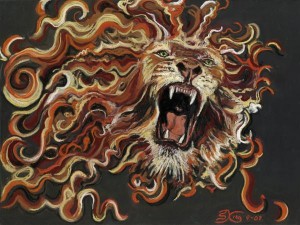 And yet God as second person does not quite quench the yearning of the human being for Goodness and Liberation, nor does it by itself solve his loneliness or his perpetual crisis of meaning and identity. If Kant and modernity taught us anything, it was this: ethics that emerge only as a response to another, no matter whom or what that other might be, will ultimately not endure. All ethical collapse results from a failure of Eros. By Eros I mean interiority, the experience of being on the inside, fullness of presence, participating in the yearning force of being and wholeness, the felt reality of the interconnectivity of the all with the all coursing through one’s own being. Interiority, Presence, Yearning and Wholeness are the four faces of Eros. When life is de-eroticized, then the human being becomes lost in the void. He then seeks all forms of Pseudo Eros to fill his very real erotic needs. He gets lost in a void-dance, dancing around the void in order to dull the pain of the shallow emptiness that his pseudo erotic quests can never fill. It is his desperate need for pseudo-erotic fulfillment in all of its forms that caused all ethical breakdowns. The human being “in relationship” with God can go very far, but, like all relationships, it is still insufficient to fully solve the core crisis of meaning and identity in one’s individual existence.
And yet God as second person does not quite quench the yearning of the human being for Goodness and Liberation, nor does it by itself solve his loneliness or his perpetual crisis of meaning and identity. If Kant and modernity taught us anything, it was this: ethics that emerge only as a response to another, no matter whom or what that other might be, will ultimately not endure. All ethical collapse results from a failure of Eros. By Eros I mean interiority, the experience of being on the inside, fullness of presence, participating in the yearning force of being and wholeness, the felt reality of the interconnectivity of the all with the all coursing through one’s own being. Interiority, Presence, Yearning and Wholeness are the four faces of Eros. When life is de-eroticized, then the human being becomes lost in the void. He then seeks all forms of Pseudo Eros to fill his very real erotic needs. He gets lost in a void-dance, dancing around the void in order to dull the pain of the shallow emptiness that his pseudo erotic quests can never fill. It is his desperate need for pseudo-erotic fulfillment in all of its forms that caused all ethical breakdowns. The human being “in relationship” with God can go very far, but, like all relationships, it is still insufficient to fully solve the core crisis of meaning and identity in one’s individual existence.
There was a time when getting married was itself the goal. Redemption was achieved when one entered into some form of committed relationship. The connection of love was thought sufficient to fill up and lend meaning to a life. Today we know, both intuitively and based on much empirical data, that while this might have once been true, it is no longer so. Today we know that if one seeks redemption from the relationship itself, then it is doomed to failure. One must first be able to walk through the void alone before one can walk through it together in a lifetime of commitment with a significant other. The crisis of meaning must be first engaged and addressed internally before it can be healed in the arena of relationship. The crisis of my own identity cannot be solved by linking my identity in relationship to another, no matter how great and noble that other might be. The only true resolution of the human identity crisis is the realization of your identity with the Divine. It is only this Eros that frees the human being from the pathetic grasping at all forms of Pseduo Eros. It is in the realization of my own highest self that I am redeemed and at the same time paradoxically opened to genuine connection. This is precisely the move from God in the second person to God in the first person.
The third level of consciousness mapped by the Baal Shem Tov is termed Hamtaka, literally translated as “sweetness.” This is the level of non-duality. This is the place of Eros. God in the first person. This is the place of ultimate realization. Not only am I in conversation with the Divine, not only are we in relationship, but on a deeper plane of reality, I AM. Here, I realize my ultimate identity with the ground of all being, with the Divine, with God. Let me say it again: The only true solution to your identity crisis is to realize your identity with God.
On Rosh Hashanah, as we will unfold, a major path towards the attainment of this non-dual realization is by becoming a Master of Tears. In learning the language of your own tears, you are introduced to the realization of your own highest divinity. This book is about the nature of this Rosh Hashanah practice of tears as the path to enlightenment.
Hidden in the esoteric teachings of the Kabbalah, emerging from this third level of Hamtaka consciousness is the radical and liberating third understanding of Melech — of Sovereign. In this reading, with deep origins in the Zohar, Luria, Cordovero and early Hassidic masters, but which comes to full formulation in the secret Torah of my teacher, Mordechai Lainer of Izbica, the King is no less than the human being himself who has realized his ontic identity with God. The Midrash already expresses this radical teaching of sweetness when it comments on the verse, “The Song of Songs that is Solomon’s.” Says the Midrash: “[Solomon the King] of whom we say that Peace belongs to him” — a play on the Hebrew for Solomon, shlomo, which implies “peace.” This is the Kabbalistic parlance for saying that the author of the Songs of Songs, the great love song of the Cosmos, is not the mortal king Solomon, but the ultimate King: God.
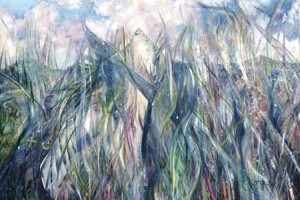 After teaching these texts to my students for some ten years in Jerusalem, I still felt somehow that the full secret of this teaching still eluded me. To try and reveal the secret, which my heart and sacred auto-biography drove me to seek to know, I spent two years virtually locked away in the Bodlian Library of Oxford University for 15 to 16 hours a day, virtually lost in a careful yet intoxicated scholarly grail quest, searching for the key to this tradition and these texts. What revealed itself, which I wrote up in a 1,400-page academic work, is roughly the following: It is not that Solomon the mortal did not write the Song of Songs; indeed he did. However, Solomon achieved what Lainer calls He’arah, literally translated as “enlightenment.” He became in Lainer’s language “liberated.” He realized his own ontic identity with the Godhead. He realized, writes Lainer, that he was the King! The radical and passionate love of the Song of Songs flowed from Solomon’s realization of his Kingship that revealed in him love, compassion and wisdom. Solomon realizes his supreme identity with the Godhead. In Mordechai Lainer’s enlightenment teachings, this secret is the very essence of the fabled Wisdom of Solomon. Lainer further makes the clear claim that he, Lainer, is the inheritor of the Wisdom of Solomon tradition. The King, who is referred to by Lainer by the code names of Judah, David and Solomon, is the one who is so deeply realized that “all of his words, even mundane words (or those said unconsciously and without intention), are the words of the living God.”
After teaching these texts to my students for some ten years in Jerusalem, I still felt somehow that the full secret of this teaching still eluded me. To try and reveal the secret, which my heart and sacred auto-biography drove me to seek to know, I spent two years virtually locked away in the Bodlian Library of Oxford University for 15 to 16 hours a day, virtually lost in a careful yet intoxicated scholarly grail quest, searching for the key to this tradition and these texts. What revealed itself, which I wrote up in a 1,400-page academic work, is roughly the following: It is not that Solomon the mortal did not write the Song of Songs; indeed he did. However, Solomon achieved what Lainer calls He’arah, literally translated as “enlightenment.” He became in Lainer’s language “liberated.” He realized his own ontic identity with the Godhead. He realized, writes Lainer, that he was the King! The radical and passionate love of the Song of Songs flowed from Solomon’s realization of his Kingship that revealed in him love, compassion and wisdom. Solomon realizes his supreme identity with the Godhead. In Mordechai Lainer’s enlightenment teachings, this secret is the very essence of the fabled Wisdom of Solomon. Lainer further makes the clear claim that he, Lainer, is the inheritor of the Wisdom of Solomon tradition. The King, who is referred to by Lainer by the code names of Judah, David and Solomon, is the one who is so deeply realized that “all of his words, even mundane words (or those said unconsciously and without intention), are the words of the living God.”
It is in this stage of consciousness that human interpretation of the law can overwhelm the Divine reading of the law. It is just such a moment that is captured in the Talmud when R. Joshua overrides the interpretation of the law offered by the Divine voice with the dramatic declaration “It is not in heaven.” In other words, the Divine law is given over to man to interpret and elucidate and God has no right to override the human interpretation of the Divine voice. This is the first glimmering of the principle of non-duality embedded in the core texts of the Talmud itself.
What is critical to understand here is that the human self-understanding as King stems from the insight, fruit of all serious spiritual practice, that all of reality is included in the Divine. Once one realizes that all is the Godhead, then one may draw one of two conclusions: First, one might say, “Well, if all is God, then I must immediately nullify and surrender to God.” And that is good. However, one might also say — “If all is God, then I am God as well.” And that is much better. The first realization produces what Jewish, Christian and Eastern mystics have called Via Passiva, a passivism — even a kind of resignation — which results from the realization that human action is but illusion and the only will which is real is the will of God. The second, far deeper realization, understands that if the human being is part of God then he is ultimately liberated. All of his actions count infinitely. He becomes the language of God; God’s adjectives, nouns, verbs, even God’s dangling modifiers. His identification with the Divine is not emasculating at all. On the contrary, it is radically liberating and empowering. His realization that there is nothing in the cosmos independent of God, the realization that is formally termed acosmism, yields not a tepid quietism but rather, as we have termed above, an audacious and impassioned “Non-Dual Humanism.” He moves beyond choice in the narrow dualist sense and all of his actions flow from his highest and most authentic self. Non-Dual Humanism, the realization that the human being is the King, is for Lainer a radical call to human activism, joy and responsibility.
However, it is even more than that. Implicit in Lainer’s teaching is a core Torah of Luria’s that becomes fully explicit in the writings of R. Kuk, who calls this teaching “the evolution of enlightenment.” Luria’s core idea, drawing on extensive earlier sources, both midrashic and Kabbalistic, is that the human being participates in the healing and evolution of God. This is what is called in Luria’s thought Tikun — the fixing, healing and evolving of God and world both are one. The entire Lurianic system of spiritual practice and intention is aimed very explicitly at the “evolving of the Divine structure” Every human being has, as part of the very essence of their humanity, a singular and irreplaceable contribution to make toward the evolution of God. This is what we have called “Soul Print.”and in later teachings, Unique Self. This is the third level of consciousness. On this level, when we say HaMelech on Rosh Hashanah, we are implicitly recognizing that only by the human being affirming his own kingship does God become King. Soul Print or Unique Self means that only when the human being evolves does God evolve. Only when the human being dies to his separate ego self, and steps into his higher authentic self in claiming his Soul Print, does God evolve and become King. This is the implication of the text in the Hebrew prophetic Book of Zechariah: “On that day…God will be King.” God is not yet King but waits for us to realize our own liberation, through which God is “freed.” It is for this reason that, according to Lainer, the human being who has attained enlightened consciousness can make a decision that contradicts the specific dictate of Torah. For in his enlightened state the human being is merged with the Divine will. The Divine will of today has significantly evolved since the Divine will expressed itself in the ancient codes. Likewise, the evolved Divine will has authority which overrides the old expression of the Divine will as codified in the formal texts and laws.
In one very explicit passage, Lainer talks about levels of consciousness in relation to Rosh Hashanah. In this complex but powerful statement, both his understanding of Kingship and the ritual of shofar, from the perspective of the third level of consciousness, that of Hamtaka, is clearly stated. Lainer talks of two levels of consciousness: Sabbath, ( Shabbat) and Temple ( Mikdash consciousness). Shabbat in his system parallels the Baal Shem’s level of Havdalah. At this level, man stands in second person relation to God and realizes that all of his actions are nullified before God. Man has no ability to act independently of God. This, says Lainer, is the explanation for the law that one does not blow the Shofar when Rosh Hashanah falls on Shabbat. Shofar is engaged as a human action of Mitzvah in fulfillment of the Divine will. All human action, however, including spiritual action, is overridden by Shabbat consciousness, which proclaims the impotence of any and all human action. All effect of human action, conceived as emerging from a human being who stands independent of God, is recognized on Shabbat as being an illusion.
However, Lainer implicitly affirms a higher level, that of Mikdash consciousness. This is the level of unity consciousness; the level beyond boundaries where the human and Divine identities merge. At this level, according to Lainer, the human being is HaMelelch — the King. All of Lainer’s images for this third level of consciousness, Judah, Solomon and David, are archetypes of Kingship. This level is manifested in the reality of the temple in Jerusalem. Temple consciousness in Lainer’s system parallels the Baal Shem’s level of Ham’taka — sweetness consciousness. At this level, one blows the Shofar even on Shabbat, because one realizes that there is no human action independent of God. Enlightened human action is the action of God. We are God’s hands, legs, eyes, ears, and hands in the Kosmos.
 For the mystic who has reached the third level of consciousness — that of Ham’taka — HaMelech, the King is none other than the fully realized and enlightened human being. According to Lainer, this is the intent of the Zohar when it describes the human spiritual path as the movement from Meriru (bitterness) to Metiku (sweetness); from the bitter, which is the world of duality, time and suffering, to sweetness, the ever-present spacious world of non-duality, timelessness and redemption. This lies at the heart of an oral tradition from Lainer’s master, Menachem Mendel of Kutzk, that on Rosh Hashanah one must not merely wish a person a Shanah Tovah, a good year; rather one must wish them a Shanah Tovah U-Metukah, a good and sweet year. For the goal of Rosh Hashanah is not less than transformation of the bitter to the sweet, the movement from separation and suffering to liberation, fullness, Eros and compassion, as it wells forth from the ultimate realization of the human being’s participation in the Divine. This is the move from God in the second person to God in the first person. It is in this sense that, together with the early Hassidic masters, we read Rosh Hashanah as “ Rosh HaShinuy.” Rosh means the beginning of, or the entry point. Shinuy means change or transformation. Rosh Hashinuy is thus “the portal of transformation.” It is Apotheosis: Man transformed into God. It is the realization of the great secret: Man and God are one. Therefore, we must take responsibility for the evolution of God, which is the healing of the world.
For the mystic who has reached the third level of consciousness — that of Ham’taka — HaMelech, the King is none other than the fully realized and enlightened human being. According to Lainer, this is the intent of the Zohar when it describes the human spiritual path as the movement from Meriru (bitterness) to Metiku (sweetness); from the bitter, which is the world of duality, time and suffering, to sweetness, the ever-present spacious world of non-duality, timelessness and redemption. This lies at the heart of an oral tradition from Lainer’s master, Menachem Mendel of Kutzk, that on Rosh Hashanah one must not merely wish a person a Shanah Tovah, a good year; rather one must wish them a Shanah Tovah U-Metukah, a good and sweet year. For the goal of Rosh Hashanah is not less than transformation of the bitter to the sweet, the movement from separation and suffering to liberation, fullness, Eros and compassion, as it wells forth from the ultimate realization of the human being’s participation in the Divine. This is the move from God in the second person to God in the first person. It is in this sense that, together with the early Hassidic masters, we read Rosh Hashanah as “ Rosh HaShinuy.” Rosh means the beginning of, or the entry point. Shinuy means change or transformation. Rosh Hashinuy is thus “the portal of transformation.” It is Apotheosis: Man transformed into God. It is the realization of the great secret: Man and God are one. Therefore, we must take responsibility for the evolution of God, which is the healing of the world.





